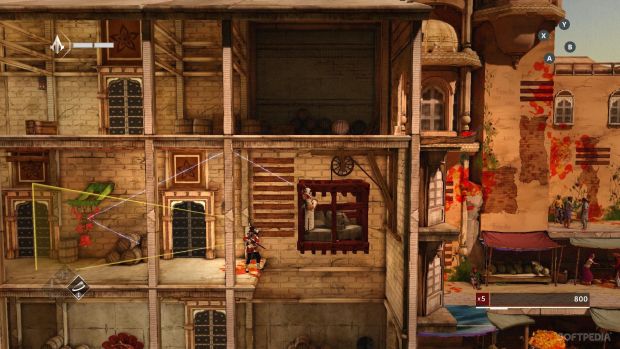The Assassin’s Creed saga has been around for many years now, starting off as an ambitious yet repetitive experience. Since then, thanks to Ubisoft’s numerous global studios, it’s grown into one of the biggest multimedia franchises out there, with yearly triple-A games, as well as smaller installments, not to mention comic books and even an upcoming Hollywood movie.
Last year’s Assassin’s Creed Syndicate managed to bring the series back from the precipice, delivering a decent experience in a new historical setting. It regained the trust of loyal fans who felt betrayed by the poor quality of Assassin’s Creed Unity and showed that the series could still deliver some fun times.
Now, Ubisoft, together with independent studio Climax, has launched the second installment in the Chronicles trilogy, in the form of India. After going on adventures in China last year, this sequel moves things a bit south, to the Indian city of Amritsar.
With a new protagonist, in the form of Arbaaz Mir, not to mention refined gameplay, better visuals, and an even more exciting historical period, can Assassin’s Creed Chronicles: India make a lasting impression? Let’s find out.
Story
Recent Assassin’s Creed titles have gone through multiple protagonists and historical settings, delivering some memorable experiences, through the likes of Rogue or Syndicate, but also some forgettable ones, like Unity and, unfortunately, the first Chronicles game, China.
For India, the series introduces Arbaaz Mir, an assassin who does his best to emulate the charming and suave Ezio Auditore from previous installments. While he may be pretty decent, the story, unfortunately, isn’t all that great, largely because there’s not that much of it.
It’s relayed to players through short animated sketches at the beginning and the end of chapters and a bit of dialog to accompany the moving pictures. The minimalistic story is decent, considering its limitations, but the historical setting and the characters have a lot potential that’s left unexplored.
The plot gives its Assassin vs. Templar take on the complex situation that was India during 1841. Assassins like Arbaaz Mir are portrayed as representatives of the common people, trying to help the Sikh Empire resist the Templar-controlled East India Company. The main goal is the control of the famous Koh-i-Noor, which is actually a very powerful Piece of Eden.
As mentioned above, however, while the plot and the characters could have helped the game deliver a compelling story, the actual result leaves a bit to be desired.
Gameplay
Those who’ve gone through Assassin’s Creed Chronicles: China will find much of the same in India. The game sticks to the 2.5D platformer core mechanics, throwing in some stealth and combat options inspired by the full-fledged triple-A titles from the game series.
The main goal is to get through the level as stealthily as possible. You can climb walls and different decorations while using pillars, darkened corridors, and other such things to hide from patrolling guards.
The game rewards players through three different styles, just like China. The first one is called Shadow and emphasizes ultimate sneaking, rewarding players who remain hidden and don’t even take down, lethally or non-lethally, any enemies. The Silencer style is for those who do favor non-lethal violence and don’t raise any alarms while the Assassin one rewards those who engage in all-out brawls with their foes.
Every stage has different bonus objectives and score goals. Reaching them nets players upgrades for Arbaaz Mir, from more health bars, to faster movement and various other combat moves. Some of these goals can be achieved more easily than others, but those who want complete Shadow playthroughs will have to endure a lot of trial and error until they pull off the perfect runs. This is largely due to the enemy AI that doesn’t always behave as you’d expect, but also the level design, which doesn’t convey all that well what the perfect path should be. While this isn’t necessarily a bad thing, getting killed over and over after missing jumps or getting spotted at the last possible moment does get pretty tedious.
Speaking of enemies, they’re a bit more varied this time around, including not just East India Company soldiers but also Sikh Empire troops, each with different weapons, like scimitars, rifles, and other such things, not to mention patrol patterns or cones of vision.
Fortunately, Arbaaz Mir also has a few new tricks up his sleeve, including a nifty new Chakram that can be employed to interact with the environment, thanks to its ricochets. You can cut ropes or even take out guards with the Chakrams, but be sure to open up chests or loot enemies in order to replenish your supply. You can also employ the now-traditional whistle to draw enemies to your position, not to mention a noise bomb that can be employed to get foes to investigate a certain location. When things get really tricky, you can also resort to a smoke bomb and try to run away.
Combat feels decent, but just like Shao Jun in Chronicles: China, Arbaaz Mir has a few problems targeting enemies. He’ll often get stuck looking at one foe in a certain direction, even if you’re trying to hit another opponent in the other way. Given enough practice, you’ll be able to move the assassin more efficiently on the battlefield, alternating between light and heavy attacks, jumping over foes, or dodging bullets from their weapons.
Exploration is decent, but there are quite a few moments in which your assassin might not go in the direction you’re pointing or ends up using a piece of the environment that puts him in contact with enemies. If things get confusing, you can always bring up the map to show an abstract view of the surroundings or the Eagle Vision mode that lets you move the camera with a wider amount of freedom than the regular one.
Mission design is relatively varied, as the game introduces a few “against the clock” sequences to add urgency to your exploration but can still become repetitive during prolonged sessions.
Besides being able to go back through the campaign on harder difficulties, you can also enjoy the Challenge mode, which offers smaller scenarios that are quite varied and pretty fun, depending on which aspects of the game appeal to you.
Controls are pretty good on PC, but as always, you’re much better off using a controller thanks to easier access to some control inputs.
Visuals and sound
Assassin’s Creed Chronicles: India is a gorgeous game largely due to the somewhat cel-shaded visual style that’s filled with vibrant colors. The title goes all-in to show just how beautiful its version of India is and reimagines trademark franchise elements, like the wagons of hay, turning them into heaps of flowers and other such things.
While the game does look great overall, the Unreal Engine shows some wear and tear, as there are very few graphics options and restarting zones once again bring into focus the texture loading that takes a couple of seconds to complete even on powerful PC configurations. It’s still baffling to see that Ubisoft hasn’t allowed Climax Studios access to its UbiArt Framework engine, which displayed fantastic results with the Rayman games, Valiant Hearts, or Child of Light.
The soundtrack is also pretty good, managing to retain the Indian style while complementing the action on the screen. It’s great to hear not just Indian accents for Arbaan and the other main characters, but also native dialects for enemies or just people found on the streets.
The Good
- Gorgeous visual style
- Interesting historical setting
- Varied stages and enemies
The Bad
- Underdeveloped story and characters
- Cumbersome combat
- Trial and error gameplay
Conclusion
Hopefully, the third installment, Russia, will manage to bring some new things while improving these lingering issues.
 14 DAY TRIAL //
14 DAY TRIAL // 




















